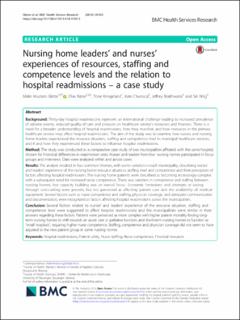| dc.contributor.author | Glette, M. K. | |
| dc.contributor.author | Røise, O. | |
| dc.contributor.author | Kringeland, T. | |
| dc.contributor.author | Churruca, K. | |
| dc.contributor.author | Braithwaite, J. | |
| dc.contributor.author | Wiig, S. | |
| dc.date.accessioned | 2021-10-25T12:02:11Z | |
| dc.date.available | 2021-10-25T12:02:11Z | |
| dc.date.issued | 2018 | |
| dc.identifier.citation | Glette, M. K., Røise, O., Kringeland, T., Churruca, K., Braithwaite, J., & Wiig, S. (2018). Nursing home leaders’ and nurses’ experiences of resources, staffing and competence levels and the relation to hospital readmissions - A case study. BMC Health Services Research, 18 (1). | en_US |
| dc.identifier.uri | https://hdl.handle.net/11250/2825367 | |
| dc.description.abstract | Background
Thirty-day hospital readmissions represent an international challenge leading to increased prevalence of adverse events, reduced quality of care and pressure on healthcare service’s resources and finances. There is a need for a broader understanding of hospital readmissions, how they manifest, and how resources in the primary healthcare service may affect hospital readmissions. The aim of the study was to examine how nurses and nursing home leaders experienced the resource situation, staffing and competence level in municipal healthcare services, and if and how they experienced these factors to influence hospital readmissions.
Method
The study was conducted as a comparative case study of two municipalities affiliated with the same hospital, chosen for historical differences in readmission rates. Nurses and leaders from four nursing homes participated in focus groups and interviews. Data were analyzed within and across cases.
Results
The analysis resulted in four common themes, with some variation in each municipality, describing nurses’ and leaders’ experience of the nursing home resource situation, staffing level and competence and their perception of factors affecting hospital readmissions. The nursing home patients were described as becoming increasingly complex with a subsequent need for increased nurse competence. There was variation in competence and staffing between nursing homes, but capacity building was an overall focus. Economic limitations and attempts at saving through cost-cutting were present, but not perceived as affecting patient care and the availability of medical equipment. Several factors such as nurse competence and staffing, physician coverage, and adequate communication and documentation, were recognized as factors affecting hospital readmissions across the municipalities.
Conclusion
Several factors related to nurses’ and leaders’ experience of the resource situation, staffing and competence level were suggested to affect hospital readmissions and the municipalities were similar in their answers regarding these factors. Patients were perceived as more complex with higher patient mortality forcing long-term nursing homes to shift towards an acute care or palliative function, and short-term nursing homes to function as “small hospitals”, requiring higher nurse competence. Staffing, competence and physician coverage did not seem to have adjusted to the new patient group in some nursing homes. | en_US |
| dc.publisher | BMC Health Services Research | en_US |
| dc.rights | Navngivelse 4.0 Internasjonal | * |
| dc.rights.uri | http://creativecommons.org/licenses/by/4.0/deed.no | * |
| dc.subject | hospital readmissions | en_US |
| dc.subject | patient safety | en_US |
| dc.subject | nurse staffing | en_US |
| dc.subject | nurse competence | en_US |
| dc.subject | financial resources | en_US |
| dc.title | Nursing home leaders’ and nurses’ experiences of resources, staffing and competence levels and the relation to hospital readmissions – a case study | en_US |
| dc.type | Journal article | en_US |
| dc.source.volume | 18 | en_US |
| dc.source.journal | BMC Health Services Research | en_US |
| dc.identifier.doi | https://doi.org/10.1186/s12913-018-3769-3 | |
| dc.source.articlenumber | 955 | en_US |

